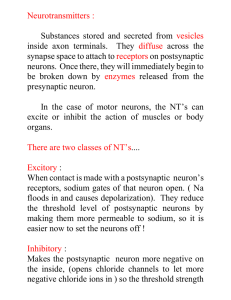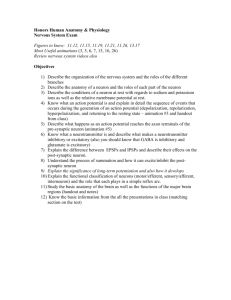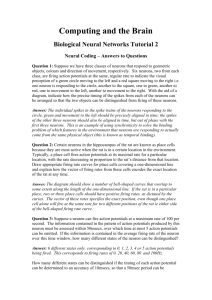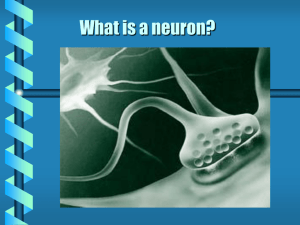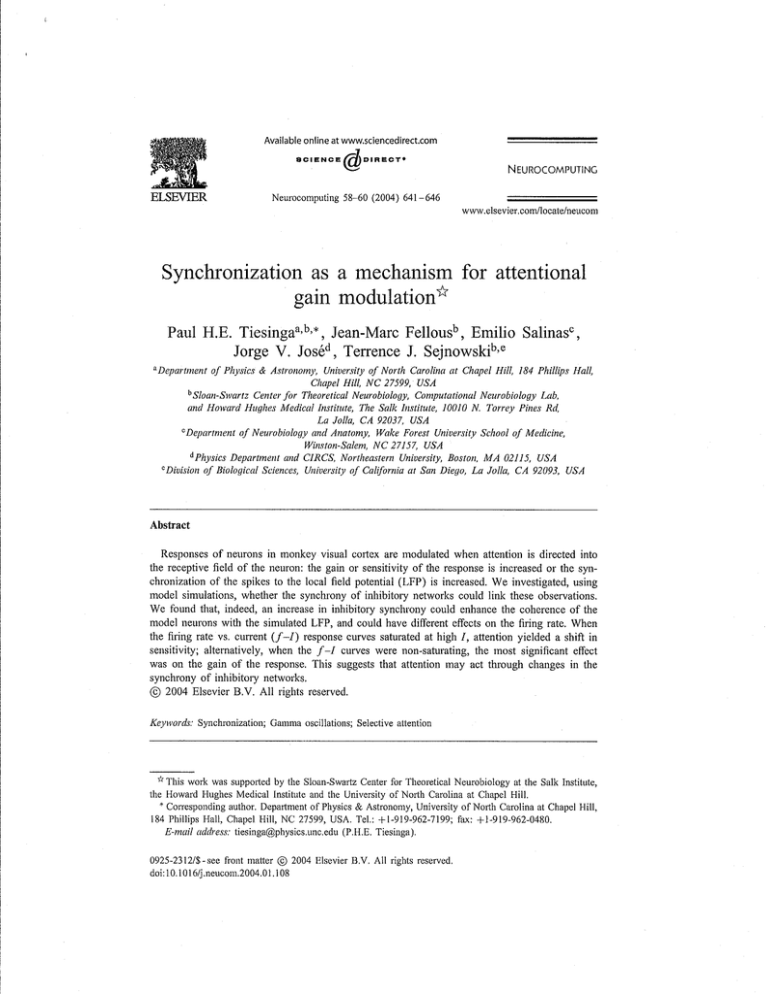
Available online at www.sciencedirect.com
s ~ l ~ N c ~ ~ D I R ~ o T e
ELSmER
Neulacomputing 58-60 (2004) 641-646
Synchronization as a mechanism for attentional
gain modulationST
Paul H.E.
~ i e s i n g a ~ ? ~Jean-Marc
?*,
el lo us^, Emilio Salinasc,
Jorge V. JosCd, Terrence J. ~ e j n o w s k i ~ . ~
aDepart~nentof Phpics & Astronomj: Universitj~of' North Carolina at Chapel Hill, 184 Phillips Hall,
Chapel Hill, NC 27599, USA
loan-Swarrz Center for Theoretical Neurobiology, Conzputationul Ne~lroDiologyLub,
and Howurd Hug1ze.s Medical Institute, The Sallc butirute, 10010 N. Torrey Pines Rd,
La Jolla, CA 92037, USA
CDepurtnwnt of Neurobiology cmd Anatomy, Woke Forest University School of Medicine,
Winston-Sulem, NC 27157, USA
d ~ h y s i cDepartment
s
and CIRCS, Northeastern University, Boston, M A 02115, USA
eDivision of Biologicnl Scienccs, University of CuliJornia at Sun Diego, La Jolla, C A 92093, USA
Abstract
Responses of neurons in monkey visual cortex are modulated when attention is directed into
the receptive field of the neuron: the gain or sensitivity of the response is increased or the synchronization of the spikes to the local field potential (LFP) is increased. W e investigated, using
model simulations, whether the synchrony of inhibitory networks could link these observations.
We found that, indeed, an increase in inhibitory synchrony could enhance the coherence of the
model neurons with the simulated LFP, and could have different effects on the firing rate. When
the firing rate vs. cuirent ( f - I ) response curves saturated at high I, attention yielded a shift in
sensitivity; alternatively, when the f-I curves were non-saturating, the tnost significant euect
was on the gain of the response. This suggests that attention may act through changes in the
synchrony of inhibitoly networks.
@ 2004 Elsevier B.V. All rights reserved.
Keyvords: Synchronization; Gamma oscillations; Selective attention
'*This work was supported by the Sloan-Swartz Center for Theoretical Neurobiology at the Salk Institute,
the Howard I-lughes Medical Institute and the University of North Carolina at Chapel Hill.
* Corresponding author. Department of Physics & Astronomy, University of North Carolina at Chapel Hill,
184 Phillips Flall, Chapel Hill, NC 27599, USA. Tel.: +I-919-962-7199; fax: tl-919-962-0480.
E-muil ndrlress: tiesinga@physics.unc.edu (P.H.E. Tiesinga).
0925-2312/$-see front matter @ 2004 Elsevier B.V. 1\11 rights reserved.
doi: 10.1016/j.neucot1~2004.01
.I08
1. Introduction
Physiological corrclates of attention have been studied by recording the response of
cortical neurons in Macaque monkey to cither oriented gratings (area V4) or random dot
pattcrns moving in different directions (arca MT) [6,12]. The firing rate in these cases
was tuned for orientation or direction, respectively. When attention was directed into the
receptive field of the recorded neuron the following changes were observed (compared
with attention directed outside the receptive field). Attention could increase the gain
of the firing rate response while the neuron remained tuned for orientationldirection
[6,12], and this effect was approximately multiplicative. Attention could also increase
the coherence of the neuron's discharge with the local field potential [3]. When the
contrast of the stimulus was varied there could be saturation effects: attention did not
increase the firing rate anymore at high contrasts [7].
Cortical interneurons are part of dedicated networks connected by gap junctions and
chemical inhibitory synapses [4,5]. Interneuron networks synchronize when activated
by excitatory neurotransmitters or neuromodulators. The firing rate of cortical output
neurons is modulated by the resulting synchronous inhibition. Here we explore using
model simulations and in vitro experiment, the hypothesis that selective attention is
mediated by changes in synchrony of local interneuron networks.
When the effect of attention is modeled as an increase in synchrony of interneuron
networks, we find that: attention increases the coherence of spike trains with the local
field potential; the firing rate can increase with attention or remain the same depending
on stimulus strength; attention results either in a gain change of firing rate response
curves or a shift in the sensitivity, depending on the extent of interneuron network
activation. Thus, changes in interneuron synchrony could potentially underlie a variety
of seemingly unrelated observations.
2. Methods
Modeling synchronous inhibitory inputs. A model interneuron network produced
an oscillatory activity that consisted of a sequence of synchronized spike volleys [I].
Each spike volley was characterized by the mean number of spikes in a volley a ~ v ,
their spike-time dispersion a~v,
and oscillation frequency f,,,(equal to the number of
volleys per second).
The method for obtaining synchronous volleys is given in Ref. [ll]. Each spike in
the volley produced an exponentially decaying conductance pulse, Aginhe~p(-t/~i,h)
in the postsynaptic cell (inh stands for inhibitory), yielding a current I,,,,,= Aginh
exp(-t/zinh)(V - EGABA).In this expression t is the time since the input spike arrival,
q,,, = 10 ms is a decay constant, Aginh is the unitary synaptic conductance, V is the
= -75 mV, is the reversal potential. The
postsynaptic membrane potential, and EGABA
resulting train of conductance pulses drove a single compartment neuron with HodgkinHuxley voltage-gated sodium and potassium channels, a passive leak current, the synaptic currents described above, and a white noise current with mean I and variance
2 0 [ll].
Stimulz~sand attention. The model was run under four sets of parameters representing the following experimental conditions: attention was eithcr directed away or
toward the receptive field of the neuron, in combination with a stimulus either present
or absent in the reccptive field. The effects of attention werc modclcd by changing thc
parameters of the synchronous inhibitory drive. The value of c~lvwas reduced in the
attended state, leading to an increase in input synchrony. The stimulus-induced synaptic
inputs that drove the neuron were not temporally patterned. The model neuron either
received a tenyorally homogeneous excitatory Poisson process with rate 3,,,,, or it was
driven by a random white noise current with mean I and variancc 2 0 .
Experiment. To validate the computer model, neurophysiological experiments in slice
were performed. These were carried out in accordance with animal protocols approved
by the N.I.H. Coronal slices of rat pre-limbic and infra limbic areas of prefiontal cortex
were obtained from 2 to 4 weeks old Sprague-Dawley rats. We recorded from regularly spiking layer 5 pyramidal cells that were identified n~orphologically.Current was
injected into the neuron using dynamic clamp [9] to mimic the effect of a oscillatory
inhibitory synaptic drive. Full experimental details are in Ref. [2].
3. Results
The model can account for results obtained in vivo. Results on attentional modulation of the firing rate and coherence of V4 neurons in macaque cortical area V4 were
recently reported in three key papers [6,7,3]. We reproduced the results by McAdams
and Maunsell [6] and those of Fries and coworkers [3] under the assumption that
attention modulates the synchrony of local interneuron networks (results not shown).
Gain modulation on neurons with highly variable spike trains. Cortical neurons can
fire at high rates with a coefficient of variation (CV) between 0.5 and 1.5. A potential consequence of driving neurons with a synchronous oscillatory inhibitory drive is
a decrease in variability [I I]. Therefore, we investigated whether attentional modulation by inhibitory synchrony could operate on neurons with high CV values (Fig. 1).
The model neuron was driven by a noisy synchronous inhibitory drive, a temporally
homogeneous excitatory Poisson process and a white noise current. The effects of attentional modulation were simulated by decreasing orv from 4 to 2 ms during the time
interval between t = 1000 and 2000 ms. During the nonattended state ( t < 1000 ms),
the firing rate was 22.3 Hz and CV= 1.0. During the attended state the firing rate
increased to 34.6 Hz, with CV =0.78. The spike field coherence (see Ref. [3]) in the
gamma-frequency band (34-44 Hz) increased by 59%.
Attentional modulation of f-I curves. Ascending sensory inputs can often be represented as a depolarizing current I . The resulting firing rate that such an input elicits
is determined by the f-I curve, the shape of which depends on the modulating inputs
to the receiving neuron. These inputs may represent the value of an additional variable,
such as attentional state. There are important computational consequences when modulating inputs change the gain of the f-I curve multiplicatively [8]. We investigated
how inhibitory synchrony altered the f-I curves.
P. R E Tiesinyu et ul. l Neuroconlputing 5840 (2004) 641 -646
Fig. 1. Increasing inhibitory input synchrony led to an increased firing rate. We show (a) the membrane
potential, (b) the local field potential (LFP), (c) the firing rate as a function of time, and (d) the rastergram
of the first 10 trials. During the time interval between I = 1000 and 2000 111s (indicated by the bar in (d)),
a ~ vwas reduced from 4 to 2 ms.
In Fig. 2A we compare the f -I curves obtained in a slice experiment for arv = 1 ms
to those for q v =4 ms for two different neurons. The response could saturate as a function of I (Fig. 2Ab), in which case reducing o1v led to a shift of the f-I curve to the
left. In the other case, the response could be nonsaturating (Fig. 2Aa) and multiplicative gain changes are in principle possible. We studied using numerical simulations
the changes in f-I over a wide range of parameters (Fig. 2B). For a1v = 10 (see
Methods), the f -I curves were nonsaturating (Fig. 2Ba). The degree of multiplicative
gain modulation was investigated by rescaling and shifting all curves, f -+ f/Af and
I t I - AI, to fit to the curve for q v = 1 ms. We found shifts Id11 up to 0.6 p ~ / c m ~
and AS as low as 0.5. This indicates that the main effect of inhibition for this parameter
range is gain modulation. For arv = 50, the f-I curves saturated at a rate equal to
the inhibitory oscillation frequency, f,,, (Fig. 2Bb). The f-I curves were well fitted
by a sigmoid function, f = A/2(1 tanh(;lI(I - dl)). Increasing ow shifted the curve
to the right (AI > 0) and stretched it (AI decreased). Hence, for this set of parameters
the change in gain was minimal.
The input activity a l is
~ proportional to the size of the network times the mean
number of neurons that are active on each cycle. The latter is determined by the extent
of electric and chemical synaptic coupling, the former is determined by the extent
of interneuron network activation by the stimulus. Hence, for small networks together
with relatively focal activation of interneuron networks, attention leads to gain changes,
+
(A)
Injected current (nA)
(B)
Injected current (pNcm2)
Fig. 2. Subtractive and divisive niodulatio~lof f - I curves with inhibitory synchrony. (A) f-I curves for
two different neurons in slices of rat prefrontal cortex. The firing rate did not saturate in (a), whereas it
did saturate in (b). In (a) and (b), for the top curve cry = I ms and for the bottom curve orv = 4 ms. (B)
Model results. (a) Multiplicative gain niodulation with inhibito~ysynchrony. an, = 10, fro111 top to bottom
orv = 1, 2, 3, 4, and 5 ms. Inset: all curves could be overlaid by a shift in the current and a rescaling of
the firing rate axis. (b) Shift in neural sensitivity with inhibitory synchrony, a ~ v= 50, from left to right,
01" = 1, 3, and 5 ms. The solid lines are fits to a sigmoid function, filled circles are simulation results.
whereas for large networks and stimuli that cause strong and widespread activation of
the interneuron network, attention leads to a shift in sensitivity.
4. Discussion
Visual scenes with enormous spatial and temporal information richncss are transduced
into spike trains in the sensory pathway. Human psychophysics indicates that only
a small part of this information is consciously accessible. For instance, differences
between two images shown in rapid succession are only visible when the subject is
told to pay attention to the particular spatial location of the change [lo]. The mechanism
for this process, selective attention, remains unclear. The neural correlate of selective
attention has recently been studied in Macaque monkeys [6,7,3]. A key finding is that
attention modulates both the mean firing rate of a neuron in response to a stimulus
[6,7] as well as the coherence with other neurons responsive to the stimulus [3].
Here we presented a simple model that could reconcile these three observations.
Sensory input was represented as a constant depolarizing current that was tuned for
orientation and increased with contrast. Attention acted by changing the synchrony of
local interncuron networks. First, increases in inhibitory synchrony led to increased
cohercnce of output spike trains with the local field potential (Fig. 1). Second, in
slice experiments we observed f-I curves that either saturated or did not saturate
(Fig. 2). For the curves that did not saturate, the firing rate always increased with
inhibitory synchrony. In that case, inhibitory synchrony could lead to gain changes.
For the curves that did saturate, the firing rate did not increase further with stimulus
strength at high contrast. The saturation firing rate was equal to the inhibitory oscillation
frequency. However, we found that the neuron could also saturate at rates corresponding
to aperiodic excitatory activity, yielding a larger range of saturation rates. We are
presently investigating constraints on the possible saturation rates.
To summarize, modulating inhibitory synchrony can account for the experimental
observations on attentional modulation of single neuron activity. The question that
remains for future study is how attention can selectively modulate inhibitory synchrony
in cortical circuits [13].
References
[I] M. Diesmann, M.O. Gewaltig, A. Aertsen, Nature 402 (1999) 529-533.
[2] J.-M. Fellous, M. Rudolph, A. Destexhe, T.J. Sejnowski, Neuroscience 122 (2003) 811-829.
[3] P. Fries, J.H. Reynolds, A.E. Rorie, R. Desimone, Science 291 (2001) 1560-1563.
[4] M. Galarreta, S. Hestrin, Nature 402 (1999) 72-75.
[5] J.R. Gibson, M. Beierlein, B.W. Connors, Nature 402 (1999) 75-79.
[6] C.J. McAdams, J.H. Maunsell, J. Neurosci. 19 (1999) 431--441.
[7] J.H. Reynolds, T. Pasternak, R. Desimone, Neuron 26 (2000) 703-714.
[8] E. Salinas, P. Thier, Neuron 27 (2001) 15-21.
[9] A.A. Sharp, M.B. O'Neil, L.F. Abbott, E. Marder, J. Neurophysiol. 69 (1993) 992-995.
[lo] D.J Simons, Visual Cognition 7 (2002) 1-15.
[I I] P.H.E. Tiesinga, 1.-M. Fellous, J.V. JosB, T.J. Sejnowski, Network 13 (2002) 41-66.
[I21 S. Treue, J.C. Martinez Twjillo, Nature 399 (1999) 575-579.
16 (2004) 251-275.
[13] P.1-I.E. Tiesinga, T.J. Sejnowski, Neural Comp~~tation



